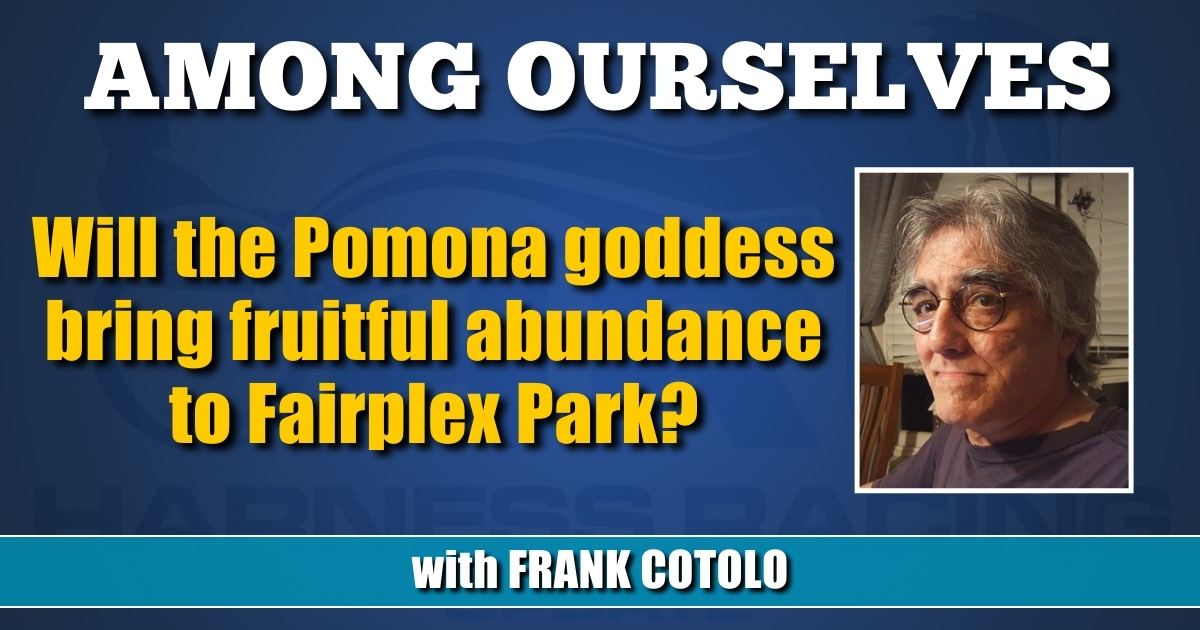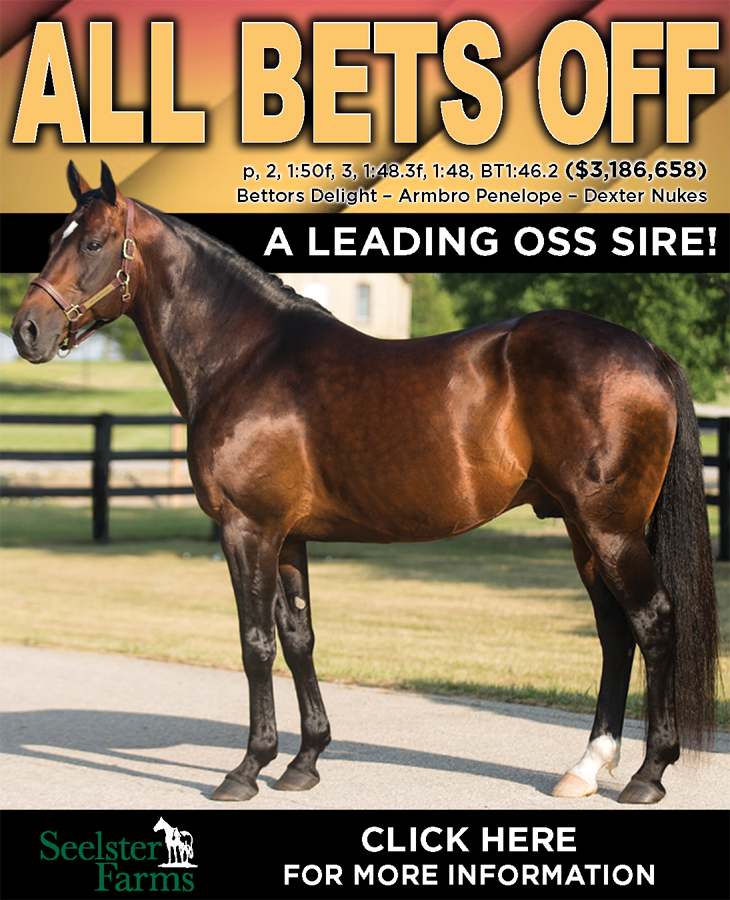

Will the Pomona goddess bring fruitful abundance to Fairplex Park?
by Frank Cotolo
I was given a similar response when I told anyone in Hollywood, I would not attend a specific media event because I was going to Pomona, CA.
“Why?” said everyone.
They speculated: “Visiting family?” “Got a new girlfriend?” “Is this some secret real estate investment opportunity I should know about?” and the most obvious, “You doing a personal appearance with the Wolfman at the fairgrounds?”
And so on. All wrong. No one fathomed my intentions for going to the “Queen of the Citrus Belt” were to bet on horse racing; no less on harness horse racing.
Mr. Bruce and I headed for the new harness racing meet’s opening night at Fairplex Park with an extra incentive — I was covering the event for a news article in the next Hoof Beats magazine. (When published the article included a photo of Mr. Bruce walking into the main entrance among a swath of people responding to much extensive promotion).
There were great expectations for harness racing in the county. Fair-association president Jim Henwood said the Pomona Valley was experiencing a population boom and boasted one of the highest per-capita income rates in the Golden State; the stuff that could only benefit a robust harness racing meet.
And the track itself?
Fairplex Park was a five-eighths-mile track best known to horseplayers for its L.A. County Fair’s brief thoroughbred meet each September. The smaller track was considered a better theater for standardbreds. Thoroughbred fans called any racetrack with more than two turns a “bullring” because the extra curve impeded speedy galloping. Pacing and trotting racehorses differed; three-turn and four-turn tracks were common across the continent for standardbred racing. That made things look good for the modern debut of harness racing in Pomona.
Then Mr. Bruce added to the positive speculation. I knew nothing about Pomona origins but he did his homework and on the long drive to Pomona for opening night he held class in the passenger seat of my Honda.
He said that inherent in the outland county were historic and mystical elements also leaning in favor of the sport’s success.
Pomona was named after a Roman myth, a goddess of fruitful abundance. Her name originates from “pomum,” Latin for fruit grown on trees and in gardens and orchards. Pomona protects and cares for their health so they may flourish against all natural enemies. The Native-American Tongva tribe lived under her protection until Spanish settlements turned it into a larger agricultural center and it became commercialized throughout the west coast fruit market.
“That’s where Hollywood got a lot of its wine during the early days of the film industry,” he said.
“Smart stuff,” I said, “but what does it mean to for us veteran harness bettors?”
“You taught me most people bet on horse racing based on feelings and superstitions,” he said. “I’m telling you this new crowd we’re betting against will wager like goddess Pomona insures Fairplex is on sacred ground and she protects their fruit. That is, their money.”
“You mean they expect winning?” I said.
“Oh yeah,” Mr. Bruce said. “For a while at least. Making bets based on feelings and superstitions will run amok with these folks. Add that to the Pomona bettors’ total lack of experience playing the sport and…”
“We have an edge.”
“Among ourselves.”
Mr. Bruce’s usual deep dive into the human condition was not as ludicrous as one would think. Remember Jim Henwood’s spin on the success of harness racing in Pomona? How it could be possible due to a population boom and high per-capita income? Where is there data to support either condition would have a minor influence on the sport’s success? The fruit goddess would have as much to do with its success. Bingo.
The few of us following harness racing on the west coast had an edge. We could only hope to be greatly outnumbered by neophytes with high per-capita incomes and faith in the goddess.
On opening night, it appeared Fairplex Park attracted a majority of the population. This was good for the sport and the article I was writing and the handle and most of all for the few of us armed with harness racing wagering experience. The Fairplex administration hired professional-gambler Barry Meadow to give handicapping lessons in the grandstands. A smart move. Meadow made a living betting on the sport. (More about him in future AO columns).
The concession stands offered food and drink and each level of the facility was festooned with colorful drapes and the seating areas were clean. The track looked to be maintained at the greatest level for safely presenting horsemen and their trotters and pacers to compete. Here too us veterans were steps ahead. We were well acquainted with the cast of characters: Stein, Kuebler, Aubin, Sleeth, Parker, Anderson, Desomer, Longo, Croghan, Bayless, Lackey, Lighthill, Plano and so on.
Then the meet began and as if the Pomona goddess held dominion over the very surface of the racetrack there was a message for those who believed in messages when the first winning harness horse at the first Fairplex Park harness program was named Winning Season.
To be continued














